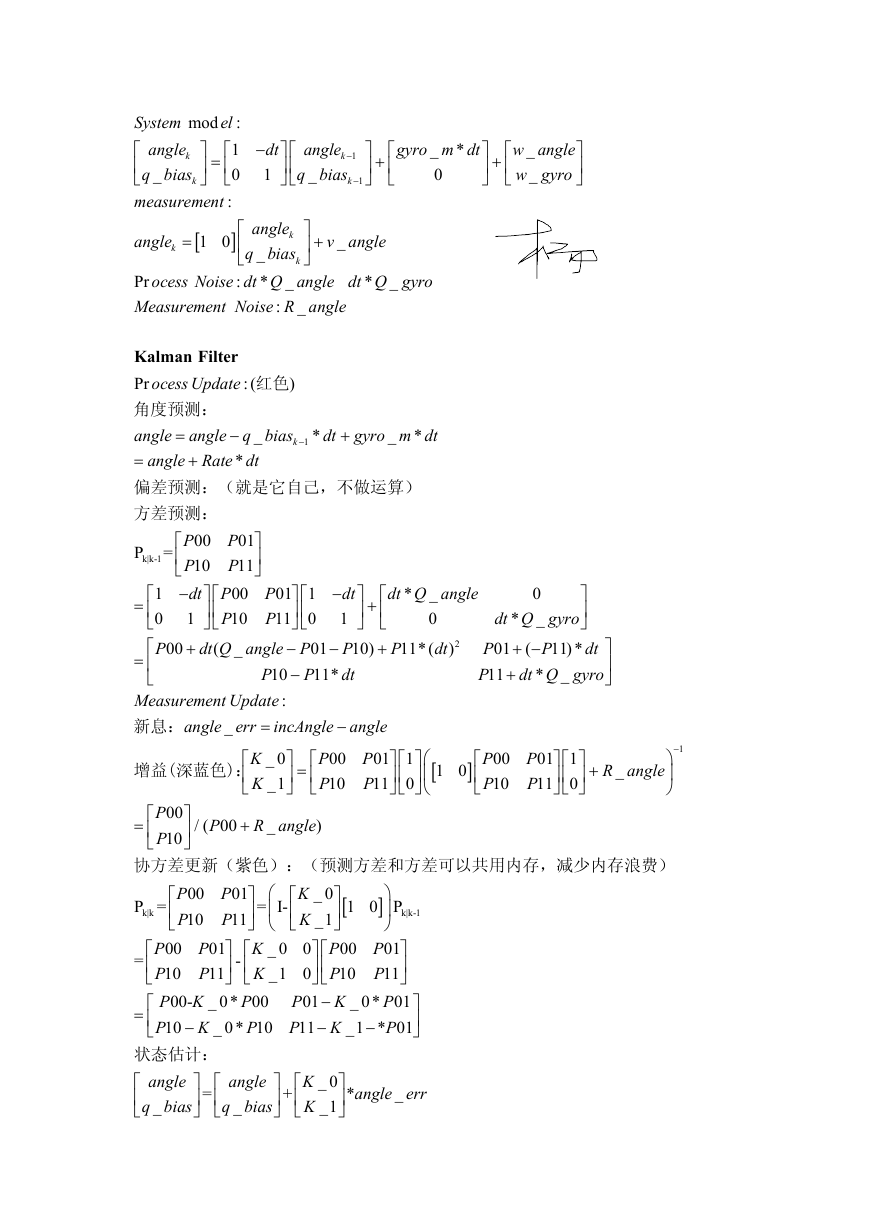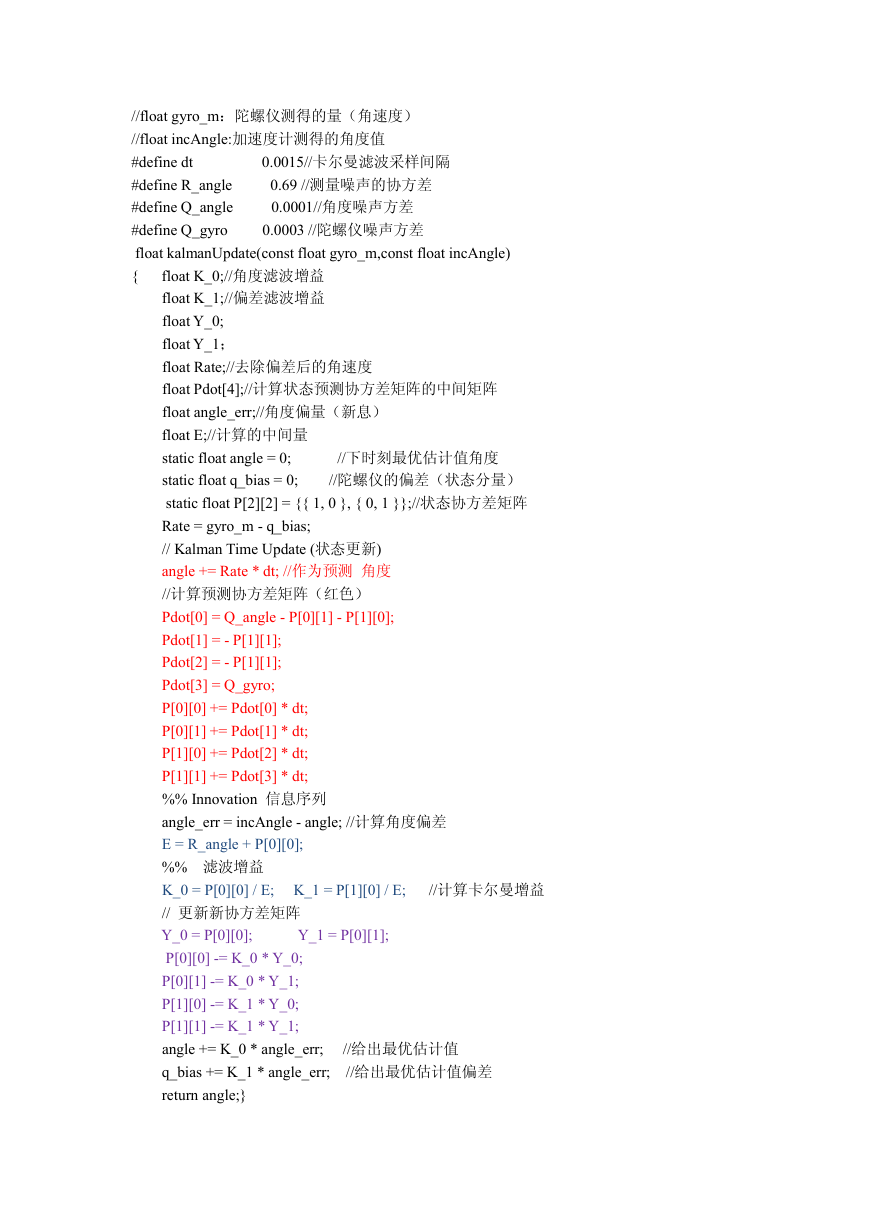11mod:1_*___010_:10__Pr:*_*_kkkkkkkSystemelangleangledtgyromdtwangleqbiasqbiaswgyromeasurementangleanglevangleqbiasocessNoisedtQangledtQgyroMeasurementNoise1k|k-1:_Pr:()_*_**0001P=1011100011*_0011011010*_kRangleocessUpdateangleangleqbiasdtgyromdtangleRatedtPPPPdtPPdtdtQanglePPdtQgKalmanFilter红色角度预测:偏差预测:(就是它自己,不做运算)方差预测:200(_0110)11*()01(11)*1011*11*_:__0000110001110_11011010110yroPdtQanglePPPdtPPdtPPdtPdtQgyroMeasurementUpdateangleerrincAngleangleKPPPPKPPPP新息:增益(深蓝色):1k|kk|k-1_00/(00_)100001_0P==I-10P1011_10001_000001=-1011_10101100-_0*0001RanglePPRanglePPPKPPKPPKPPPPKPPPKPP协方差更新(紫色):(预测方差和方差可以共用内存,减少内存浪费)_0*0110_0*1011_1*01_0=+*____1KPPKPPKPangleangleKangleerrqbiasqbiasK状态估计: �
//float gyro_m:陀螺仪测得的量(角速度)
//float incAngle:加速度计测得的角度值
#define dt 0.0015//卡尔曼滤波采样间隔
#define R_angle 0.69 //测量噪声的协方差
#define Q_angle 0.0001//角度噪声方差
#define Q_gyro 0.0003 //陀螺仪噪声方差
float kalmanUpdate(const float gyro_m,const float incAngle)
{ float K_0;//角度滤波增益
float K_1;//偏差滤波增益
float Y_0;
float Y_1;
float Rate;//去除偏差后的角速度
float Pdot[4];//计算状态预测协方差矩阵的中间矩阵
float angle_err;//角度偏量(新息)
float E;//计算的中间量
static float angle = 0; //下时刻最优估计值角度
static float q_bias = 0; //陀螺仪的偏差(状态分量)
static float P[2][2] = {{ 1, 0 }, { 0, 1 }};//状态协方差矩阵
Rate = gyro_m - q_bias;
// Kalman Time Update (状态更新)
angle += Rate * dt; //作为预测 角度
//计算预测协方差矩阵(红色)
Pdot[0] = Q_angle - P[0][1] - P[1][0];
Pdot[1] = - P[1][1];
Pdot[2] = - P[1][1];
Pdot[3] = Q_gyro;
P[0][0] += Pdot[0] * dt;
P[0][1] += Pdot[1] * dt;
P[1][0] += Pdot[2] * dt;
P[1][1] += Pdot[3] * dt;
%% Innovation 信息序列
angle_err = incAngle - angle; //计算角度偏差
E = R_angle + P[0][0];
%% 滤波增益
K_0 = P[0][0] / E; K_1 = P[1][0] / E; //计算卡尔曼增益
// 更新新协方差矩阵
Y_0 = P[0][0]; Y_1 = P[0][1];
P[0][0] -= K_0 * Y_0;
P[0][1] -= K_0 * Y_1;
P[1][0] -= K_1 * Y_0;
P[1][1] -= K_1 * Y_1;
angle += K_0 * angle_err; //给出最优估计值
q_bias += K_1 * angle_err; //给出最优估计值偏差
return angle;}
�




 2023年江西萍乡中考道德与法治真题及答案.doc
2023年江西萍乡中考道德与法治真题及答案.doc 2012年重庆南川中考生物真题及答案.doc
2012年重庆南川中考生物真题及答案.doc 2013年江西师范大学地理学综合及文艺理论基础考研真题.doc
2013年江西师范大学地理学综合及文艺理论基础考研真题.doc 2020年四川甘孜小升初语文真题及答案I卷.doc
2020年四川甘孜小升初语文真题及答案I卷.doc 2020年注册岩土工程师专业基础考试真题及答案.doc
2020年注册岩土工程师专业基础考试真题及答案.doc 2023-2024学年福建省厦门市九年级上学期数学月考试题及答案.doc
2023-2024学年福建省厦门市九年级上学期数学月考试题及答案.doc 2021-2022学年辽宁省沈阳市大东区九年级上学期语文期末试题及答案.doc
2021-2022学年辽宁省沈阳市大东区九年级上学期语文期末试题及答案.doc 2022-2023学年北京东城区初三第一学期物理期末试卷及答案.doc
2022-2023学年北京东城区初三第一学期物理期末试卷及答案.doc 2018上半年江西教师资格初中地理学科知识与教学能力真题及答案.doc
2018上半年江西教师资格初中地理学科知识与教学能力真题及答案.doc 2012年河北国家公务员申论考试真题及答案-省级.doc
2012年河北国家公务员申论考试真题及答案-省级.doc 2020-2021学年江苏省扬州市江都区邵樊片九年级上学期数学第一次质量检测试题及答案.doc
2020-2021学年江苏省扬州市江都区邵樊片九年级上学期数学第一次质量检测试题及答案.doc 2022下半年黑龙江教师资格证中学综合素质真题及答案.doc
2022下半年黑龙江教师资格证中学综合素质真题及答案.doc